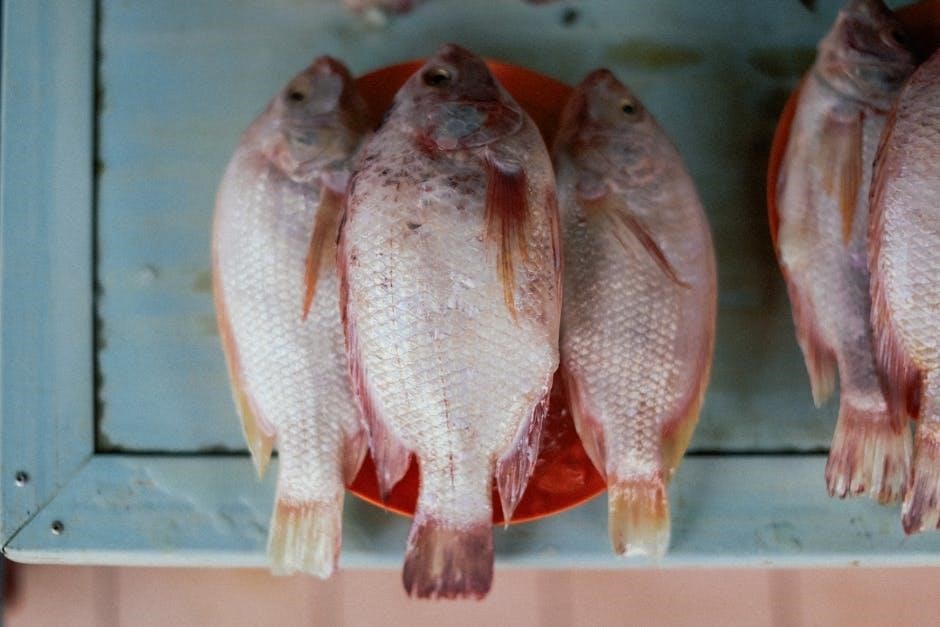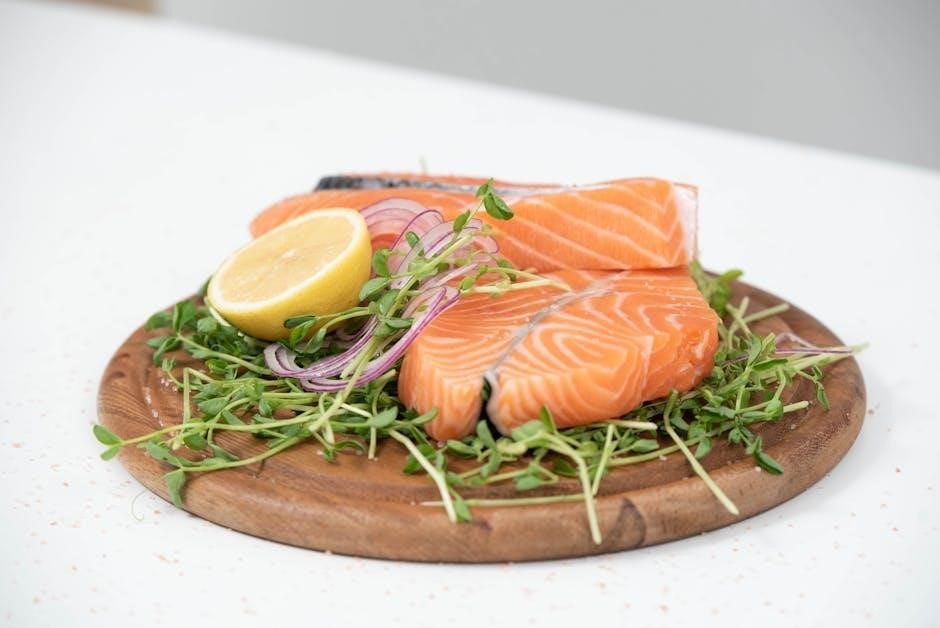The pescatarian diet combines vegetarian principles with the inclusion of fish and seafood, offering a balanced and nutritious eating pattern that emphasizes sustainability and health benefits.
1.1 What is a Pescatarian Diet?
A pescatarian diet is a primarily vegetarian eating pattern that includes fish and seafood while excluding meat from land animals. It emphasizes plant-based foods like fruits, vegetables, grains, and legumes, with the addition of fish and seafood as protein sources. This diet is often chosen for its health benefits, environmental sustainability, and ethical considerations. It offers a balanced approach to nutrition, combining the versatility of vegetarian meals with the nutritional perks of fish and seafood.
1.2 Benefits of a Pescatarian Lifestyle
A pescatarian lifestyle offers numerous benefits, including increased protein intake from fish and seafood, which are rich in omega-3 fatty acids. This diet promotes heart health, supports brain function, and reduces inflammation. By combining plant-based foods with seafood, it provides a balanced approach to nutrition. Additionally, it aligns with sustainability goals and ethical choices, appealing to those who want to minimize environmental impact while enjoying a diverse and nutritious diet.

Core Components of a Pescatarian Food List
A pescatarian food list includes seafood, fish, plant-based foods, and dairy or eggs. It emphasizes variety, sustainability, and nutrient-rich options for a balanced lifestyle.
2.1 Seafood and Fish Options
A pescatarian food list includes a variety of seafood and fish, such as salmon, tuna, shrimp, mussels, and cod. These options are rich in protein, omega-3 fatty acids, and essential nutrients like vitamin D and selenium. Fatty fish, like salmon and mackerel, are particularly beneficial for heart health. Shellfish, such as mussels and oysters, provide iron and zinc. When choosing seafood, opt for low-mercury varieties and consider sustainable, wild-caught, or responsibly farmed options to support both health and environmental sustainability.
2.2 Plant-Based Foods in a Pescatarian Diet
A pescatarian food list emphasizes plant-based foods like fruits, vegetables, whole grains, legumes, and nuts. These provide essential vitamins, minerals, and fiber, complementing seafood and fish. Leafy greens, berries, and cruciferous vegetables are rich in antioxidants. Legumes, such as lentils and chickpeas, offer plant-based protein, while whole grains like quinoa and brown rice provide sustained energy. Incorporating a variety of these foods ensures a balanced and nutritious diet, aligning with the pescatarian lifestyle’s focus on health and sustainability.
2.3 Dairy and Egg Inclusions
Dairy and eggs are integral to a pescatarian food list, offering versatility and nutrition. Milk, yogurt, cheese, and eggs provide high-quality protein, calcium, and essential vitamins like B12 and D. These foods complement plant-based and seafood options, enhancing meal variety. Eggs are a versatile source of protein and nutrients, while dairy supports bone health. Incorporating these into a pescatarian diet ensures a balanced intake of nutrients, aligning with the lifestyle’s focus on health and sustainability.
Health Benefits of a Pescatarian Diet
The pescatarian diet offers numerous health benefits, including improved heart health due to omega-3-rich seafood, reduced inflammation, and lower risks of chronic diseases like heart disease and diabetes.
3.1 High Protein Intake from Fish and Seafood
Fish and seafood are excellent sources of high-quality protein, essential for muscle repair and growth. Fatty fish like salmon and mackerel are rich in protein and omega-3s, while lean options like cod and tilapia provide lean protein. Shellfish, such as shrimp and mussels, are also high in protein and low in calories. Incorporating a variety of seafood ensures a balanced intake of essential amino acids, supporting overall health and satiety in a pescatarian diet.
3.2 Rich in Omega-3 Fatty Acids
Fatty fish like salmon, mackerel, and sardines are rich in omega-3 fatty acids, which support heart health, reduce inflammation, and enhance brain function. These essential fats are crucial for overall well-being and cannot be produced by the body, making seafood a vital component of a pescatarian diet. Regular consumption of omega-3s can lower triglycerides, improve blood flow, and contribute to mental clarity, making fish a nutritious and beneficial choice for those following this dietary pattern.
- Key sources: Salmon, mackerel, sardines, tuna, and anchovies.
3.4 Lower Risk of Chronic Diseases
A pescatarian diet is associated with a reduced risk of chronic diseases, such as heart disease, type 2 diabetes, and certain cancers. The inclusion of fish and seafood provides essential omega-3 fatty acids, which help lower triglycerides and blood pressure, improving cardiovascular health; Additionally, the emphasis on plant-based foods, fiber, and lean protein supports overall well-being. Avoiding processed meats further contributes to a healthier profile, making this diet a beneficial choice for long-term health and disease prevention.
Meal Planning and Grocery Shopping Tips
Effective meal planning and organized grocery shopping are key to maintaining a balanced pescatarian diet, ensuring access to fresh seafood, whole grains, and nutritious plant-based options.
4.1 Weekly Meal Planning Ideas
A well-structured weekly meal plan ensures variety and nutrition in a pescatarian diet. Start with salmon or tuna salads on Mondays, followed by grilled fish with quinoa and vegetables. Midweek, incorporate seafood stir-fries with tofu and mixed greens. Fridays can feature paella or seafood pasta. Weekends might include fish tacos and hearty vegetable soups; Balance each meal with whole grains, legumes, and fresh fruits. Batch cooking and grocery lists help maintain consistency and reduce meal prep time throughout the week.
4.2 Essential Grocery Items for Pescatarians
Stock your pantry with fresh and canned seafood like salmon, tuna, and shrimp, along with whole grains, beans, and vegetables. Include plant-based staples such as brown rice, quinoa, and leafy greens. Dairy products like yogurt and eggs, and healthy fats like olive oil and nuts, are also key. Don’t forget herbs and spices to enhance flavors without added salt or sugar. Regularly replenish your supply of fresh fruits and vegetables to maintain a balanced and versatile pescatarian diet.

Budget-Friendly Pescatarian Options
Affordable pescatarian choices include canned tuna, mackerel, and frozen fish. Incorporate plant-based staples like beans, grains, and vegetables to reduce costs while maintaining nutritional balance and variety.
5.1 Affordable Fish and Seafood Choices
Canned tuna, mackerel, and sardines are cost-effective protein sources. Frozen fish like tilapia, salmon, and cod offer affordability without sacrificing quality. Shellfish such as shrimp, mussels, and clams are budget-friendly, especially when purchased frozen or in-season. These options provide high protein and omega-3s, making them nutritious additions to meals. Incorporating them into salads, stir-fries, or pasta dishes ensures variety. Exploring local markets for seasonal seafood can also yield savings, helping you maintain a pescatarian diet without breaking the bank.
5.2 Cost-Effective Plant-Based Alternatives
Beans, lentils, and chickpeas are affordable plant-based proteins rich in fiber and nutrients. Whole grains like rice, quinoa, and oats provide sustainable energy. Canned vegetables and frozen produce are budget-friendly and nutritious. Tofu and tempeh offer versatile, cost-effective alternatives to meat. Incorporating these staples into meals helps maintain a balanced diet while reducing expenses. These options complement seafood and fish, ensuring a varied and nutritious pescatarian lifestyle without breaking the bank.
Popular Pescatarian Recipes
Popular pescatarian recipes include flavorful seafood paella, grilled salmon salads, and shrimp stir-fries with tofu. These dishes offer variety, nutrition, and delicious flavors for any meal.
6.1 Easy Seafood Recipes for Beginners
Easy seafood recipes for beginners include garlic shrimp, tuna salad, and baked salmon. These dishes are simple to prepare, requiring minimal ingredients and basic cooking techniques.
Start with quick sautés or oven-baked options to build confidence. Incorporate fresh herbs and lemon for flavor without complexity.
These recipes are perfect for those new to cooking seafood, ensuring delicious and healthy meals with minimal effort. They also align with the pescatarian food list, promoting variety and nutrition.
6.2 Balanced Meal Ideas Combining Fish and Vegetables
Balanced meals combining fish and vegetables offer a nutritious and flavorful approach to pescatarian dining. Try pairing grilled salmon with roasted asparagus and quinoa or baking cod with steamed broccoli and sweet potatoes.
A seafood stir-fry with shrimp, bell peppers, and snap peas is another quick and healthy option. These combinations ensure a mix of lean protein, omega-3 fatty acids, and essential vitamins, making them ideal for a well-rounded pescatarian diet.

Culinary Medicine and Pescatarian Diets
Culinary medicine emphasizes the role of food in health, with pescatarian diets offering a rich source of nutrients from fish and seafood to promote well-being and longevity.
7.1 The Role of Fish in Promoting Health
Fish plays a vital role in promoting health within a pescatarian diet. It is an excellent source of essential nutrients like omega-3 fatty acids, vitamin D, and selenium. These components are known to support heart health, reduce inflammation, and enhance brain function. Regular consumption of fish has been linked to a lower risk of chronic diseases such as heart disease and certain types of cancer. Additionally, fish provides high-quality protein, which is crucial for muscle repair and growth. Incorporating a variety of fish, such as salmon, sardines, and mackerel, ensures a broad intake of these beneficial nutrients. Furthermore, fish is versatile and can be prepared in numerous ways, making it an ideal component of a balanced and nutritious diet. As highlighted in recent studies, the inclusion of fish in the diet contributes significantly to overall well-being and longevity.
7.2 Using Food as Medicine in Pescatarian Meals
Pescatarian meals emphasize the concept of food as medicine, leveraging the therapeutic properties of fish, seafood, and plant-based ingredients. Omega-3 fatty acids in fish reduce inflammation, while antioxidants in vegetables combat oxidative stress. A balanced pescatarian diet supports immune function, improves mental health, and aids in chronic disease prevention. By incorporating nutrient-dense foods, individuals can harness the healing potential of their meals, promoting overall well-being and longevity. This approach aligns with the principles of culinary medicine, where diet serves as a powerful tool for health.

The Impact of Plant-Based Meats on Pescatarian Diets
Plant-based meats offer pescatarians versatile, sustainable substitutes for traditional seafood, aligning with ethical and environmental values while maintaining nutritional balance and flavor variety in meals.
8.1 How Plant-Based Meats Fit into a Pescatarian Lifestyle
Plant-based meats provide pescatarians with sustainable, ethical alternatives to traditional seafood, reducing the need for fishing while maintaining protein intake and offering versatile meal options that align with their lifestyle choices.
8.2 Consumer Preferences and Food Practices
Consumer preferences for pescatarian diets often reflect a desire for sustainable and ethical food choices. Many individuals opt for plant-based meats due to their health benefits and environmental impact. These products align with the pescatarian lifestyle by offering versatile meal options that cater to both convenience and taste preferences. The growing demand for such alternatives highlights a shift toward mindful eating, where consumers prioritize nutrition, flavor, and sustainability in their food practices.
Adopting a pescatarian diet offers numerous health and environmental benefits. Download our comprehensive pescatarian food list PDF to start your journey toward a balanced and sustainable lifestyle today!
9.1 Summary of Key Points
The pescatarian diet blends vegetarianism with fish and seafood, offering a nutrient-rich, sustainable eating pattern. It promotes high protein intake, omega-3 fatty acids, and lower chronic disease risks. Plant-based foods and dairy complement the diet, while budget-friendly options like canned fish and seasonal produce make it accessible. Culinary medicine highlights fish’s health benefits, and plant-based meats add versatility. Download the pescatarian food list PDF for a comprehensive guide to balanced, delicious meals that support overall well-being and environmental sustainability.
9.2 Downloadable Pescatarian Food List PDF
Download our comprehensive pescatarian food list PDF for a detailed guide to essential foods, including fish, seafood, plant-based options, and dairy. This resource simplifies meal planning and grocery shopping, ensuring a balanced diet. Discover budget-friendly choices, seasonal produce, and versatile ingredients. Perfect for beginners or experienced pescatarians, this PDF provides inspiration and practical tips to enhance your culinary journey. Make informed food decisions and enjoy a sustainable, nutritious lifestyle with this handy reference.

